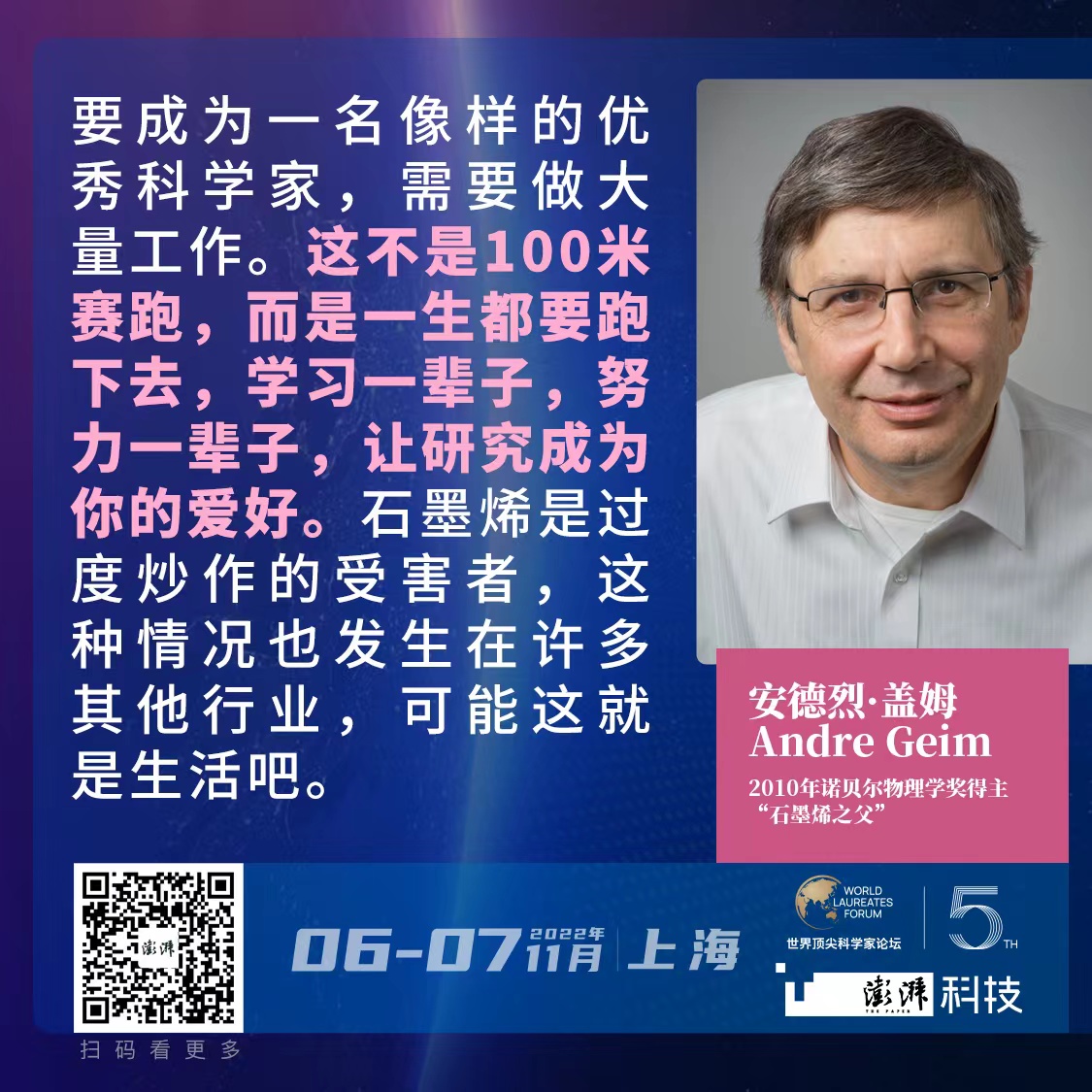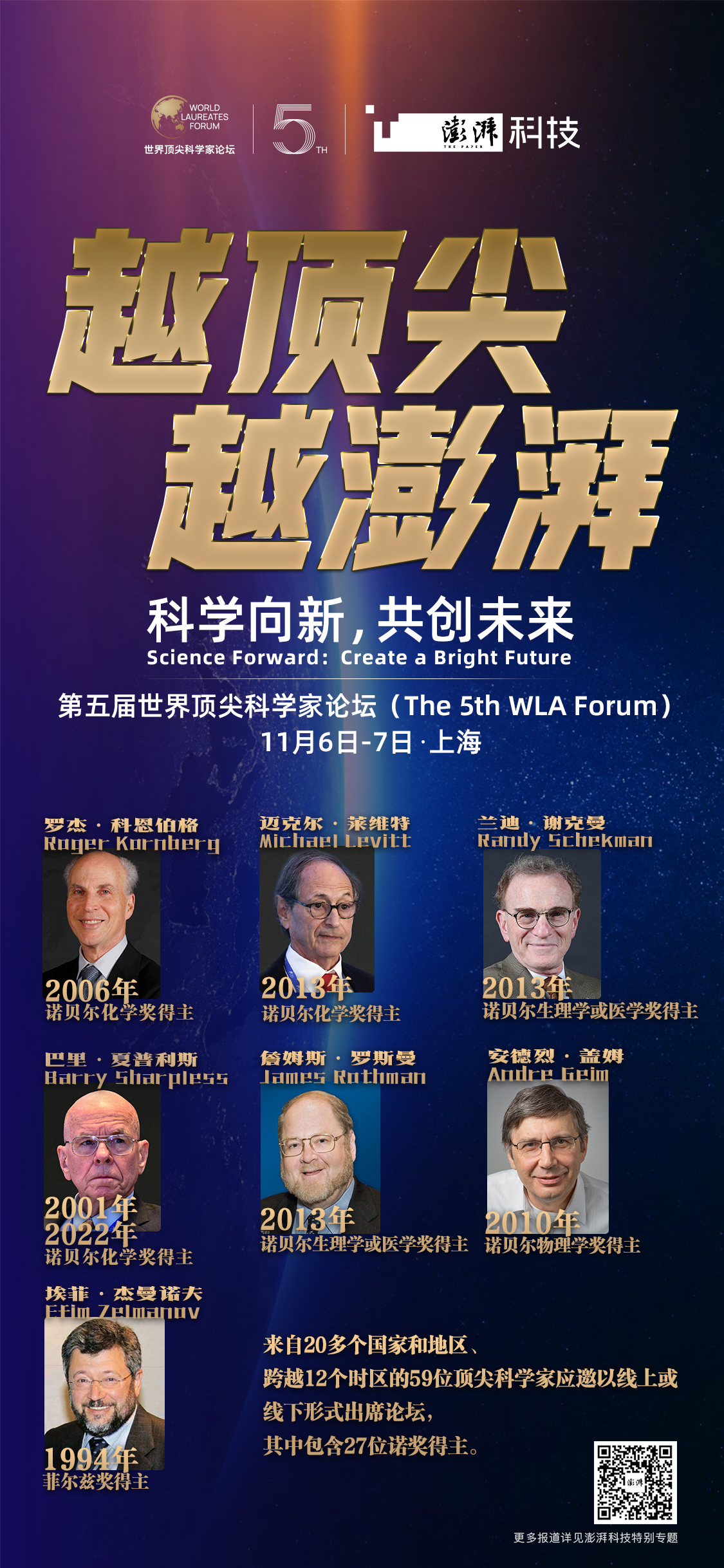
"Graphene becomes an advertised selling point for so many products that may not improve any of those products' properties at all."
"It takes a lot of work to be a decent scientist. It's not a 100-meter race, it's a lifetime of running, a lifetime of study, a lifetime of hard work, and making research your hobby."
Andre Geim, a Nobel Prize winner in physics known as the "father of graphene", was once very angry at the "magical effects" of graphene mentioned in advertisements, and now he can Looking at it calmly, "people have to realize that there are agencies out there to see if an ad is accurate. But in a sense, graphene is a victim of over-hype."
On November 5th, Geim, who is now a professor at the University of Manchester, UK, said in an exclusive interview with The Paper (www.thepaper.cn) on the eve of the opening of the 5th World Top Scientists Forum.

Nobel Laureate in Physics Andre Geim speaks at the 2nd Carbon Congress of the World's Leading Scientists.
Graphene is a single-layer sheet-like structure material composed of carbon atoms, which is only one carbon atom thick and belongs to two-dimensional materials. In 2004, Geim and Konstantin Novoselov obtained a single-layer graphite structure by "tear-off tape". They used ordinary tape to peel off the graphene layers with pure graphite until only one layer of graphene remained. After dissolving the tape assembly in acetone and drying, the graphene could be observed under a microscope. Six years later, Geim and Novoselov were jointly awarded the 2010 Nobel Prize in Physics for this pioneering experimental study.
When we talk about graphene, we're actually not just talking about graphene, but also graphene's many "siblings," which are known as two-dimensional materials, Game said. Although there does not seem to be any revolutionary application at present, in the future, through continuous improvement, the quality of the product will be further improved to achieve revolutionary application, but we still have to wait 10 or even 20 years.
Born in Sochi, Soviet Union in 1958, Geim went to Moscow to study at the Moscow Institute of Physics and Technology (Phystech) in the 1970s, and then briefly worked at the University of Nottingham in the UK, before being appointed as a professor at Radboud University Nijmegen in the Netherlands. Associate Professor. In 1997, Game put a frog into a strong magnetic field and got a "suspended frog", which won the "Ig Nobel Prize in Physics" in 2000.
In 2001, Game entered the University of Manchester to teach. In a proof-of-concept study in 2003, he succeeded in creating a small piece of "gecko tape" that works the same way as gecko toe sticky. Previously, a team of American scientists said that geckos can climb walls because their toes are covered with billions of fine hairs that generate intermolecular forces.

Andre Geim in the lab with Konstantin Novoselov. They shared the 2010 Nobel Prize in Physics.
A Spider-Man model hangs from the roof of Game's lab to show off its stickiness. Over the next decade, similar experiments were carried out around the world, enabling flat-screen TVs to be suspended from tiny, ultra-sticky materials that could soon hit the market.
A year after the gecko experiment, Game and his team successfully isolated a layer of graphite, which he named "graphene."
For his contributions to three cutting-edge researches on magnetic levitation, gecko tape and graphene, Game has been named one of the most active scientists in the world by Thomson Reuters many times. He's always trying to find something no one has discovered, and he's used to jump from one field of study to another every five years.
Game says his curiosity gives him an adrenaline rush, and when he discovers something new, he thinks it's a "eureka moment" (a moment when inspiration strikes and makes a big discovery). This adrenaline and curiosity drive him to find interesting things.
"Real interesting research is like a multi-dimensional chess, not an 8x8 board. Take something from one area of expertise, take something from another discipline, and try to combine it into something that might interest me, never before Something no one has ever discovered." He sees it as a mind game that he's been playing his whole life.
In fact, being a scientist is hard. Game advises young researchers, "It takes a lot of work to be a decent scientist. It's not a 100-meter race, it's a lifetime of running, a lifetime of study, a lifetime of hard work, and making research yours. Hobby."

The following is a transcript of the conversation between The Paper and Andre Game.
Pengpai Technology: What is the main focus of your recent work?
Game: I work as usual, and I try to find something new, something no one else has found before. I used to jump from one field to another every 5 years. I think the same thing will happen with graphene. We started graphene research in 2004, and 3 to 4 years later, as a research topic, graphene will end its life cycle. But graphene is proving to be an amazing material, as it reinvents itself and takes on a new life every five years.
After graphene, there are other 2D materials that are also very popular right now. In a van der Waals heterojunction, you can put different materials into a design strategy to create a new material that doesn't exist in the universe. They are entirely artificial and are not created by coincidence.
Graphene superconductivity, graphene conductors, etc., there have been many issues in recent years. Now we're trying to use all these materials to make something new and interesting. For example I jumped into an area that people didn't study, all of us focused on our own research, focused on what happens in low temperature conditions, what happens in specific scientific conditions that only exist in the laboratory , not around us. My Nobel Prize was awarded for studying these properties. Last year we started looking at what happens to a material at room temperature, and it's not the same as before. So there are a lot of things that are still unknown. Graphene is just short for that class of 2D material. We have to study this whole class of material. Fortunately, we are living in a good age where you don't need to ask yourself what to study and what you want to study.
The Paper: Does that mean you need to be curious to do research?
Game: Curiosity is very important to me. Curiosity gives me an adrenaline rush, but I'm not an adrenaline addict. It's like a "Eureka moment" when we discover something new. This adrenaline and curiosity drives me to look for these things. So I'm still a very active researcher.
Surging Technology: Graphene has many applications, how will it change people's lives?
Game: When we talk about graphene, we're not really talking about graphene, but graphene's many "siblings." These materials are called two-dimensional materials. While graphene is a treasure, there are other materials that can be used to improve our lives in physics, science, industrial applications, and more. Just as the Stone Age used stone and the Bronze Age used bronze, people used these materials to improve their lives. Now we live in the age of silicon, plastic, aluminum, and these materials define our lives. Without those willing to take risks, we wouldn't have the objects we use today and the comforts of life.
Fifteen years ago a new class of materials emerged that we didn't know about. In fact, these materials cannot even exist in theory. Now we are looking for these materials and studying their properties. The next step is to use these materials to improve our lives. Graphene is an amazing material. It usually takes 40 to 70 years for a material to move quickly from academia to science, such as plastics, aluminum, but graphene is now showing up in many different new products. You won't hear the word graphene when referring to these products, but graphene will improve the performance of these products in some places. In another 10 to 20 years, graphene and its "brothers and sisters" will continue to improve our lives.
Surging Technology: How do you view graphene as a marketing tool in the current market? For example, some products claim to use graphene in advertising and marketing, so how to distinguish which is scientific and which is contrary to basic science?
Game: Yes, I know a lot of companies that advertise the magic of graphene in their products. 3 to 5 years ago, I was very angry with this type of goods, but then I understand the phenomenon more deeply. Like when you see some TV stars or actors advertise and they say a product is great, but I'm not sure if the advertiser is actually using the product. This is just an advertisement. Graphene has become an advertised selling point for so many products that may not improve any of those products' properties at all.
So people have to realize that there are specialized agencies to find out if the advertisement is accurate. But in a sense, graphene is the victim of overhype. But it's unavoidable, and this happens in many other industries. Maybe this is life.
Surging Technology: In your opinion, what is the next milestone in graphene research, and which application field has the most potential and can make great progress?
Game: It's hard to answer that question because graphene is a "nickname" for a large class of materials that have potential in different industries.
Graphene, for example, has been hailed as a new material driving the development of the electronics industry. This material is now believed to have advantages over silicon in certain areas of the electronics industry. And some other two-dimensional materials also seem to be better than their "predecessors". Graphene probably covers every conceivable application field. From batteries to medical diagnostics, to the apparel industry. Even in concrete buildings, covering the road with a 2D material can improve the performance of the road. While there doesn't seem to be any revolutionary application at the moment, in the future, through continuous improvement, the quality of the product will be further improved to achieve revolutionary applications, and that's when you say "wow, there would be no such thing without graphene". But we still have to wait 10 years, maybe even 20 years.
Surging Technology: You once obtained a single-layer graphite structure by tearing off the tape. How to realize original innovation in scientific research, and what kind of research environment is needed to support original innovation?
Game: If I knew the answer, if anyone knew the answer to how to inspire innovation, you probably wouldn't be asking this question. Innovation is very difficult and it depends on the people involved. It depends on how good the students are and how good the professors are at encouraging research. How much money the government and researchers invest in also matters. When funding is insufficient, research can become very boring, there is no innovation, and science can become very boring when people use outdated equipment and stop competing with each other. I did my PhD in Soviet times and I didn't have good equipment back then, so it was really boring. Then I moved to the UK, Denmark and the Netherlands, where I could innovate with good equipment, because I had the money and I had equipment that wasn't the best, but it was also very good. A good education, decent investment and competition lead to innovation.
Surging Technology: What is the driving force that drives your continuous scientific research and exploration?
Game: Really interesting research is like a multi-dimensional chess, not an 8x8 board. Take something from one area of expertise, and something from another discipline, and try to combine it into something that may interest you and that no one has explored before.
It's a mind game, played all your life. For a scientist like me who is really interested in my work, doing research is a hobby, and this mental game is very addictive and more interesting than the computer games of young people.
The Paper: When was the highlight of your career?
Game: Of course, the discovery of graphene was a very pleasant experience, a "Eureka moment." But there are other bright moments in my life that I could never have imagined that this experiment of mine would be very popular among laymen, about 25 years ago, I did an experiment of levitating frogs with strong magnetic fields, and levitating water and other animals, etc. .
It was a simple experiment that took me a short time to put water in a strong magnetic field and see it levitate. These beautiful videos of floating water can be found online.
Surging Technology: Did you encounter any obstacles before you achieved great achievements?
Game: I come from the bottom, very bottom. I'm not one of those people who was born into the scientific elite. In a prosperous country, I was born at the bottom and got to where I am now.
Surging Technology: What advice would you give to young scientists or young people and young students?
Game: When scientists look very attractive. In fact, being a scientist is hard. It's a boring, low-paying job. But it takes a lot of work to be a decently good scientist. This is not a 100-meter race, but a lifetime of running, studying for a lifetime, working hard for a lifetime, and making research your hobby.



